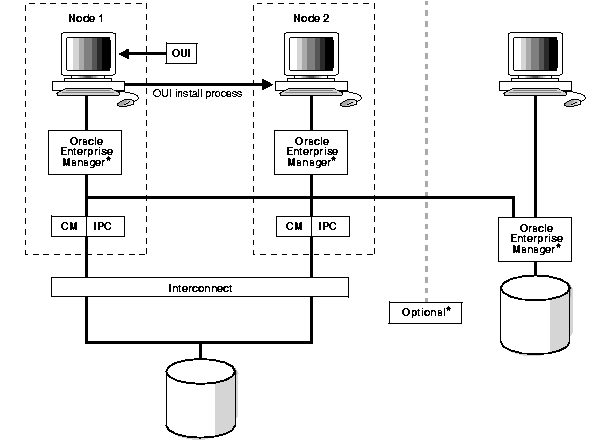| Oracle9i Real Application Clusters Setup and Configuration Release 2 (9.2) Part Number A96600-02 |
|
|
View PDF |
| Oracle9i Real Application Clusters Setup and Configuration Release 2 (9.2) Part Number A96600-02 |
|
|
View PDF |
This chapter provides an overview of the procedures and components for installing and configuring Oracle Real Application Clusters. This chapter includes the following topics:
The Oracle9i Enterprise Edition, which is required for Real Application Clusters, provides single-instance database software and the additional components to operate Real Application Clusters databases. Some of the Real Application Clusters-specific components include:
ORACLE_HOMEThe clusterware contains operating system-dependent (OSD) components that control the operating system and clusterware. The OSD's two primary subcomponents are the Cluster Manager (CM) and the Interprocess Communication (IPC) software. Figure 1-1 illustrates these components in more detail.
racpacth directory on the first CD-ROM before installing and configuring Real Application Clusters.The Oracle Universal Installer (OUI) provides a graphical user interface for the installation of the Oracle Enterprise Edition software. Figure 1-1 shows the OUI process flow.

When the OUI runs, Oracle Corporation recommends that you select one of the preconfigured databases or use the Database Configuration Assistant (DBCA) interactively to create your cluster database. You can also manually create your database. If you are not using a cluster file system, then you must have configured shared raw devices before proceeding with database creation.
When you install Real Application Clusters, the installer copies the Oracle software onto the node from which you are running the installer. The OUI then propagates the software onto the other nodes that you have selected for installation.
The OUI can also install the software for the system management tool, Oracle Enterprise Manager (EM), to integrate this tool into your cluster environment. Or you can install EM onto other client machines outside your cluster as shown in Figure 1-1 (*).
The Oracle Intelligent Agent is installed when you install EM. The Oracle Intelligent Agent must be running on each node that is part of your Real Application Clusters database so that EM can discover and manage the database.
See Also:
|
All instances in Real Application Clusters environments share the control file, server parameter file, redo log files, and all datafiles. These files reside on a shared cluster file system or on shared disks. Either of these types of file configurations are accessed by all the cluster database instances. Each instance also has its own discrete set of redo log files. During failures, shared access to redo log files enables surviving instances to perform recovery.
The Real Application Clusters installation process includes four primary tasks.
Verify that your system meets the requirements discussed under the following topics before proceeding with installation:
Verify the following hardware and software requirements for each node:
Each node in a cluster requires the following hardware:
Each node in a cluster requires the following software:
http://www.netscape.com
http://www.microsoft.com
To use Oracle Managed Files (OMF) for a Real Application Clusters databases your platform must support a cluster file system. The OMF feature enables the Oracle database server to automatically create and delete files that Oracle requires to manage the database.
| See Also:
Oracle9i Database Administrator's Guide for more information about Oracle Managed Files |
Interconnects that support Real Application Clusters and Cache Fusion use one of the following protocols:
Real Application Clusters can use any interconnect product that supports these protocols. You can also use other proprietary protocols that are hardware vendor-specific. The interconnect product that you use must be certified by Oracle for your Oracle9i Real Application Clusters hardware platform.
| See Also:
Oracle9i Real Application Clusters Concepts for more information about Cache Fusion |
32-bit instances cannot share access to the same 9.2 database with 64-bit instances. Depending on the platform, for example, 32-bit and 64-bit Oracle9i Real Application Clusters executables cannot be used at the same time within the same cluster domain. This is because some cluster manager implementations may not be able to concurrently manage 32-bit and 64-bit clients.
If you have installed and configured the required hardware and software and you are not using a cluster file system, then proceed to Chapter 2 to configure the shared disks. Otherwise, proceed to Chapter 3 if you are using a cluster file system.